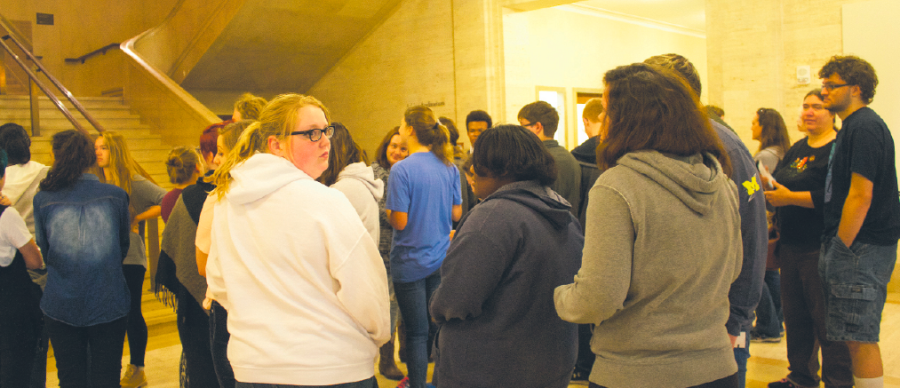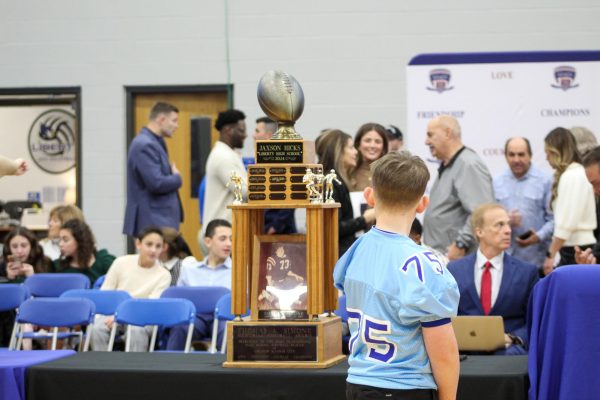Seurat on the Spot
The College World Literature classes had a field trip at the Nelson Atkins Art Museum on October 1. The show lasted about two and a half hours with a 15 minute intermission between the two acts. This was a Kansas City Repertory Theatre show that was held at the Nelson because of the renovations going on at UMKC. This was the first time a show of the KC Rep. was held there.
Being able to attend this was a really special opportunity because students could not have recreated something like this at school.
“Our principals support us doing this because it’s a really good opportunity to get something outside of the classroom environment that we can’t replace in the building,” English teacher Karla Schaeffer said.
Sunday in the Park with George is a musical about the painter George Seurat. It tells the story of how he created the painting, “A Sunday Afternoon on the Island of La Grande Jatte.”
The beginning of the play starts with George in the park telling his mistress, Dot, to hold still so he could sketch her.
“I noticed because I was sitting in house left, I got to see the inside of his sketchbook that he was actually sketching,” senior Nate Ewbank said.
Act Two was confusing to most because it started off with the characters telling that George had died. Compared to the cliché of every struggling artist committing suicide, George died of an unknown illness at age 31.
“I was confused to what would happen next because I thought that would be the ending,” junior Sydney McBee said.
As Act Two continued, it showed how George Seurat’s great grandson had followed in his footsteps and was an artist as well as an inventor. The great grandson had new ideas of adding electronic lights instead of paintings. The play ends in Paris, where he is told to try new ideas and create his own style.
There are many what if’s still unknown to the story.
The first one includes the grammar book. The grammar book showed that Dot was learning how to read and write. The book ended up actually showing how Dot had been telling her story like a diary and gave the audience clues of how the relationship between her and George played out.
The second one includes the painting that Dot had asked for. She asked George to give her the painting of her in the park but he would not. If he had, he may not have created the painting “A Sunday Afternoon on the Island of La Grande Jatte.” It could have changed the way he painted and the way he would have continued his career as an artist.
The way the characters were portrayed contrasted the way they truly might have been during the late 1800’s. They also gave background to the painting.
“George is shown as the tortured genius/artist that no one understands,” Schaeffer said.
Dot is shown as being kind of dumb because she cannot read or write but she understands human interaction, whereas George does not.
The Americans were portrayed as very Southern rich folks. They were very consumed with themselves and just cared for the pastries rather than the art.
Before going to the show the students had a project they were doing in class. It was a Gallery Walk of impressionist and post-impressionist artists. There were multiple similarities of the artists. The students noticed that most painters during the impressionism and postimpressionism era were very self-oriented and kind of acted like jerks towards others. For example, the artist, Paul Gauguin left his family just because that is what he wanted to do. George was portrayed that way as well in the play.
“He wasn’t being a jerk on purpose, it’s just how he was,” Ewbank said.
The painting was projected on the stage to create the background on the set. There were easels with white canvases that showed a multitude of Seurat’s actual paintings. The projector zoomed in and out of different paintings consisting of the main painting as the background.
“The entire second act was zooming in on a painting so you’d see the entire thing and throughout the whole entire act it eventually went all the way until it was white and I thought that was so cool,” McBee said.
Towards the end, the painting of “A Sunday Afternoon on the Island of La Grande Jatte” lit up in all the places where Dot was shown. There were four to six places where she was shown in the painting. It gave a completely different perspective on the painting after that.
The costumes even matched the original painting.
“I’ve seen the real painting multiple times in person before and I’ve looked at prints millions of times and I still noticed things I’ve never seen before,” Schaeffer said.
Some of the interpretations of the play compared to seeing the painting was often similar, but not exact.
“When they were going to have a child, I expected the two center people in the painting to be Dot and the baby but it turned out that she was actually on the side,” junior Nathan Moody said.
A lot of the show was real and a lot of the characters were truly inspiring pieces to the painting.
“I thought it was neat the characters they chose to highlight from the painting, most the people they chose were in the very front of the painting but the soldiers were all the way in the back,” sophomore Lily Bogue said.
When they recreated the paintings with the actors the audience would look back and forth between the painting and the characters to see how they portrayed it.
“It was kind of cool how at the end of the first act right before everyone started walking off stage they had recreated the painting with the actors they had on stage,” senior Sam Browning said.
All the elements were put together for a concluding purpose.
“When I read or see a play, I like them to come around to the full circle and they did that in the play with ending with the blank canvas,” junior Katherine Shaffer said.






